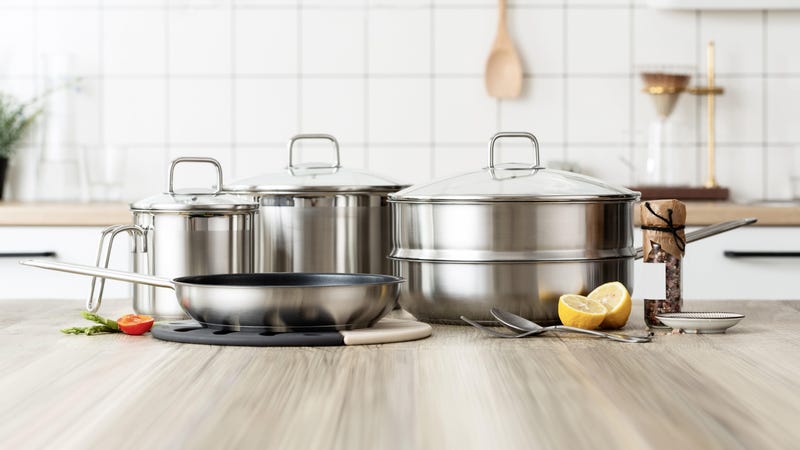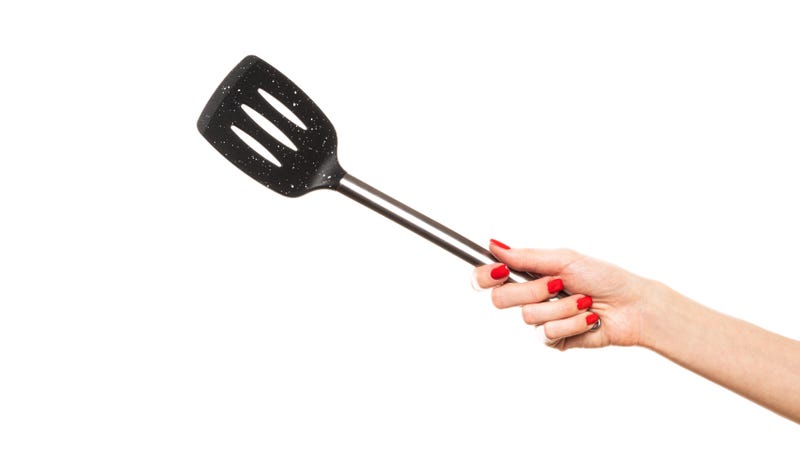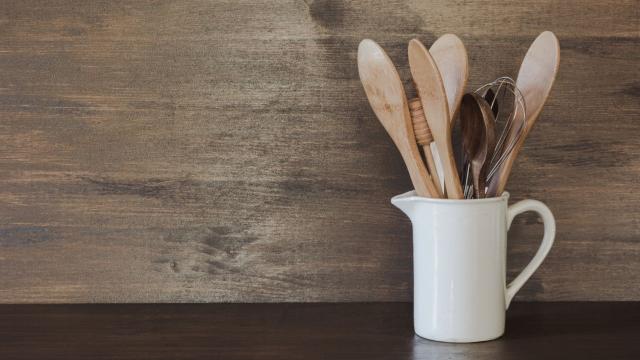Building your official grown-up kitchen involves selecting big ticket items–cast iron skillets, stainless steel pans, and a set of knives you treat like family–but don’t forget about the little guys. Your utensil holder (that big cylinder from IKEA full of spatulas that sits next to your stove) has likely been overrun with redundant store-bought sets and dusty ladles you barely recognize. Here’s how to clear out the clutter and stock your utensil holder according to your cooking style and needs.
Clear out the nonsense
The first step to filling a clown car is to empty the clown car. The first time I emptied my utensil holder to assess the tools, I was surprised at the sheer number of things I’d managed to squeeze inside. At least 25 per cent of the items were dupes. Literal doubles of the same size, material, even angle in some cases. Luckily, this made decision making easy for me–the duplicates were the first to lose holder status.
It’s possible that a person might need two of the same wooden spoon or two ladles. I did keep some duplicates, because I’ll need them for my annual holiday party, but only one secured a spot in my utensil holder. Think of the utensil holder as your tool belt, and only load it with what you need on a daily basis.
I suggest making three piles. One for daily use, one for occasional use, and pile that I call “say goodbye.” The tools in your “daily use” pile are the final candidates for the utensil holder. The “occasional use” tools will need a new home, probably in a cabinet or drawer. “Say goodbye” items should be trashed or donated, depending on their condition.
Select your top tools
Now you have two piles of keepers. It’s possible that you’re good to go at this point, and have discerned the few tools that go in the holder. However, if you’re anything like me, you probably still have too many tools in the “daily use” pile. A utensil holder should have enough space for a tool to be easily removed, without taking the rest of the utensils with it. You shouldn’t have to yank five things out just to get one spoon, so a few more tools need to get the boot.
Most 7-inch wide utensil holders can hold around 12-16 thin-handled tools. Choose your top 10 tools. These should be like picking out comfy clothes–the tools that make you feel good; you reach for them because you know exactly what meals you make with them.
For me, it’s a non-metal spatula, three differently sized rubber spatulas, a wooden rice spoon, a metal fish spatula, a long-handled wooden spoon, a slotted wooden spoon, a flat-head wooden implement, and this weird metal spoon that is the best scooping spoon in the world, but has no name. (It’s wide but pointed at the end, and a little beat up. I took it from my mom’s kitchen because I can’t find them anywhere.) Identify the 10 items you love, and put them in their place of honour.
Consider your cookware

If you’ve never cooked before and this is your first utensil holder, don’t worry. It’s okay if you don’t know which tools serve which purpose. Even if you don’t yet know what kind of cook you’re going to be, consider your cookware, and choose the most compatible tools.
Non-stick pots and pans
Non-stick cookware works well because it is treated with a non-stick coating, usually Teflon or a ceramic compound. Keeping this coating in good shape is key to your pan’s longevity. Metal utensils will scrape the non-stick finish off, so stick with non-metal tools. Heat-resistant plastic, rubber, or silicone spatulas, as well as wooden utensils will keep the finish safe.
Stainless steel pots and pans
Don’t underestimate the importance of the hardworking stainless steel pan. Stainless steel cookware is usually composed of several metals to help conduct heat evenly and efficiently across the base, but the outer layer, the surface you’ll cook on, is stainless. You want to keep the finish in good shape, but unlike with non-stick surfaces, metal tools are okay. Since you can get such a good sear in stainless pans, you’ll want a plain metal spatula and a metal fish spatula on hand. Tongs will be helpful for flipping steaks. You’ll also need a flat-head wooden spatula for pan sauces. As long as you don’t dig into the finish with a fork, or steel wool, most utensils are safe.
Cast iron equipment
Cast iron is the toughest, hardiest of your pan arsenal and, apart from rust, nothing will take it down. Cast iron is excellent for holding heat, so if you’re venturing into baking cornbread, searing meats, or deep frying, pull out your cast iron. Use metal tools (a flat, offset spatula, and metal tongs will do well for you here) as natural materials like bamboo and wood can wear down on the cast iron texture with frequent contact. High-temperature silicone is okay too.
Baking tools
If weekend morning pancakes and school bake sales are a constant part of your life, you’ll benefit from keeping high-use baking tools nearby. I have long, medium, and small rubber spatulas, and they all live in my utensil holder because I use them constantly. Not just for batter; rubber spatulas will help you scrape every bit of pasta sauce out of the pot, or salad dressing out of the measuring cup.
Specialty equipment
Consider any specialty items you cook or gadgets you use. If there’s a tool that does one thing really well and you need it frequently, it belongs in your utensil holder. I have a short, bamboo rice paddle because I make rice a lot. If you deep fry doughnuts every day, you might need a wooden chopstick or a deep-fry spider.
Promote tools as needed

You’ll likely keep more than 10 tools in your utensil holder, but anything other than your top 10 should earn its spot. If you notice you keep pulling the same tool out of the “occasional use” area, promote it to the utensil holder. You can make space by clearing another utensil, or expanding to two utensil holders. (There is no law against having two.)
Skip these utensils
Space is precious in that seven-inch wide tube, and there are a few tools that over-complicate things. Deeply consider if you need to put these in the utensil holder, or if they can have a separate home.
- Tongs: I know I just said you might need these, but their odd shape can lead to them getting caught amongst the other tools. Instead of sticking tongs in the utensil holder, hook them over the side and lock them in the closed position if you can. This will help them keep them out of the way.
- Whisks: I love my whisks but they’re a nightmare in the utensil holder. The bulk of wires on the head takes up a ton of space, and if you’re not careful, other tools will get caught in the wires. It’s annoying to detangle, but dreadful for the whisk if the wires get bent out of shape.
- Potato masher: Hands down, mashed potatoes are my favourite side dish. However, the large, flat head of the potato masher, fixed perpendicularly to the handle, makes it a bad neighbour in the utensil holder. It might be wise to find this one a new home.
- Rolling pin: Although I’ve only seen this in stock photos, I fear it might be more prevalent than I know. Don’t keep rolling pins in the utensil holder; they’re just too big. The weight combined with the length might topple the whole container over.
Everyone’s utensil holder will look different. The more you cook, the more your holder will take shape. Your final collection will change over time, so take stock of what’s in there every now and again to ensure it continues to best serve your cooking style.
Lead Image Credit: iStock

Leave a Reply
You must be logged in to post a comment.